Many Shopify merchants make the mistake of overly focusing on their product pages when doing Shopify SEO. And while product pages are absolutely the backbone of an eCommerce website, collection pages usually carry the most potential for non-branded traffic. Collection pages are also incredibly scalable and require little resources to create, as there are virtually endless use cases and occasions you could assign to one particular set of products.
In this article, you will learn more about what Shopify collections are, how you can edit them, and what the best practices for Shopify collection page SEO are.
What is a Collections Page in Shopify?
A Collections page in Shopify is a page that displays products grouped by a common property to make it easier for eCommerce customers to navigate the site.
What is the difference between collections and products on Shopify?
Sometimes, new online merchants can confuse the term collections with product bundles. Products in a bundle or set sold together (for example, a set of 3 pairs of socks) would still be considered one product. Collection pages nest multiple products and bundles under one roof.
Are Shopify collections the same as categories?
Shopify categories refer to the taxonomy you assign to your Shopify products, while collections are the actual pages that automatically display all items of a specific taxonomy. Collections can also be added manually, unrelated to the taxonomy.
For example, an eCommerce site that sells men’s clothing may have collection pages based on different product types – like pants and sweaters. The product types are assigned to the products as they’re being added to the Shopify inventory. All products added to the site that contain the sweater tag will automatically be included in the “Sweaters” collection page.
However, perhaps the merchant also wants to have a “Holiday” collection on the site that displays only a few hand-picked items. In that case, a manual collection is the better option instead of a dynamic one.
What Do You Need to Do Before Optimizing Your Shopify Collection Pages for SEO?
Before you can optimize a collection page, you should make sure that you have done your keyword research. Collection pages are a great avenue to explore non-branded keyword targeting and attract more website visitors.
Using Ahrefs or SEMrush, here are a few tips on SEO keyword research for eCommerce Shopify collection pages.
How to do Keyword Research for your Shopify Collections
Search for Long-Tail Keywords
Short-tail keywords have more search volume, but they’re also more difficult to rank for.
For example, the ranking difficulty for variations of the query “mens sweaters” is 60>, according to SEMrush data:

The second we add another word to make the keyword combination more long-tail, the difficulty estimate drastically drops:
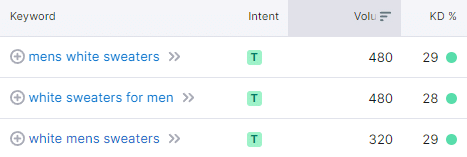
The more specific you go with finding keywords that describe your product to a T, the more likely that the keyword difficulty will continue to drop:

Long-tail keywords are not only easier to rank for – they also capture users that are further down the conversion funnel. For example, ranking for something like “mens sweaters”, while getting you more exposure, may be a case of shooting in the dark when it comes to the likelihood of someone making a purchase. More likely, these users are still in the browsing stage of their buyer journey.
On the other hand, users looking for “mens white cardigan sweaters” are much more likely to convert on the spot, as they have a better understanding of exactly what they want – making them closer to the conversion stage.
Check the Search Intent
The best way to determine if a keyword is a right fit for you is to see what’s already ranking for it. Share on XThis is Google’s way of saying “Here’s what kinds of products users searching this particular query are interacting with”.
For example, does “mens white cardigan sweaters” describe your product offering well?
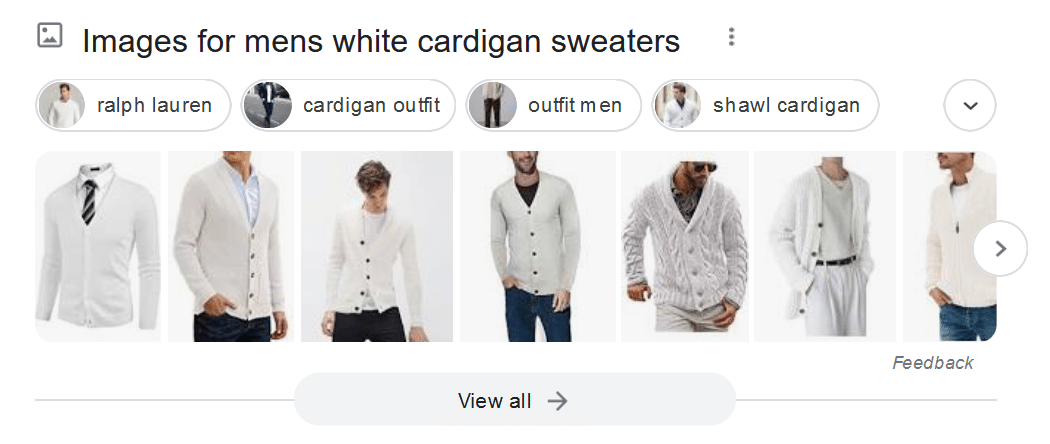
Or do you see your sweaters better fit the query “mens white pullover sweaters”

Once you have found attainable keywords that describe your product well and match your search intent, it’s time to implement them on the site by editing your collection page SEO.
How do you edit collection page SEO on Shopify?
- Edit the Title Tag and Meta Description
When clicking to edit your unoptimized Shopify Collection page, at the very bottom – you should see a “Search Engine Listing” section. Clicking to edit this section will allow you to change the Title and Meta Description of the Collection.
You can also enter a custom URL slug for your collection page.

From an SEO perspective:
- Shopify Collection Page titles should be no longer than 55 characters long (before the branded tag) to not be cut off on search engine results pages. The title should contain your focus keyword at the beginning of the title rather than toward the end.
- The collection page URL slug should be short and descriptive. For example, if you have a blue pants collection, then your URL would be www.store.com/collections/blue-pants
- Meta descriptions should contain a call to action that will entice users to click through. They should also contain the focus keywords, as search engines bold search queries on meta description previews – making them stand out more.
- Add a Block of Text at the Top of the Collection Page
At the very top of the Shopify Collection Page, add some copy that includes your target keywords and briefly explains to visitors what’s in the collection. If possible, also include the collection’s unique selling point.
- Edit the Image Alt Text
Image alt text is important because it increases your chances of ranking for image results rather than just regular search results. Alt text should succinctly describe what’s in a given image. For example, “white wool sweater with golden buttons on cuffs”.
On the right side of Shopify’s editor, you should see a “Collection Image” field. Click on the image, or upload an image – if you don’t have one already. Then, you will be prompted to add the alt text to your featured collection page image.

- Add the Collection to your Navigation
Not every collection page needs to be linked to your top navigation bar. Some specific sub-collections may be better suited as links on your high-level collections. However, you should list the most important collections in your menu navigation to decrease their crawl depth, as well as make them easier for users to access.
In your Shopify menu, go to the Sales Channels section on the left hand side, and click on “navigation”. You can edit your top navigation and add/remove pages from here.
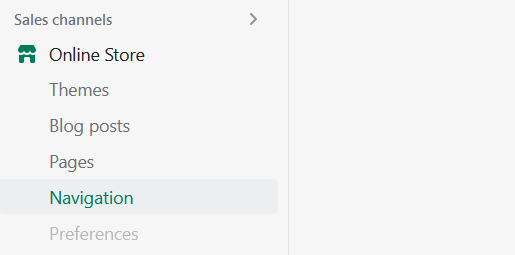
How do you optimize a collection page?
If you have developer assistance at your disposal, here are a few more things to add to collection pages to give them more authority and make them more engaging for your on-site visitors.
- Include FAQs
Frequently asked questions are an important part of SEO and by targeting them you can greatly increase your chances of ranking on Search Engine Results Pages. In fact, FAQs are one of the best ways to attract new organic customers.
You can source FAQs about your product from the People Also Ask box on Google, but the questions you choose to write about may also come directly from interactions you’ve had with customers.
In terms of formatting your FAQs, ask your developer to add another copy block to the bottom of your collection pages, and include the FAQ answers there.
FAQs increase the chance of your collection pages to appear in a People Also Ask box, but it also helps build trust with your buyers – as they don’t have to defer off-site to see the most important information about the things you’re selling.
Example of a query that one of our client’s targeted via the People Also Ask box:
Targeted Query:
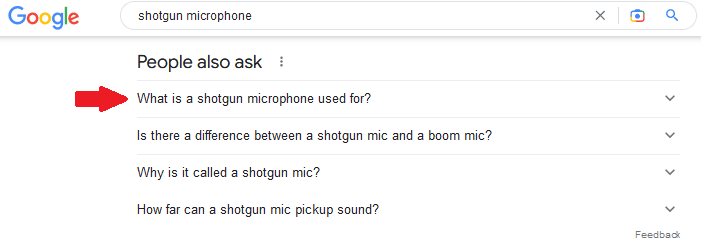
FAQ:

- Include CTAs to Other Sections of your Website
There is a chance that your target customer lands on a collection page and realizes they need more information before they make a purchase, or that this particular type of product doesn’t suit their needs the best. By linking to other collections, products, or even blog posts on your collection pages can help indecisive buyers realize what it is exactly that they want.
Example of internal links to other blog posts on a camera collection page:

- Add Reviews and Testimonials
Unlike product pages, adding reviews for collections is atypical because customers wouldn’t be reviewing the entire collection – but rather, the one particular item they bought. However, collection pages are a great place to showcase some of your best reviews and testimonials. Again, this will lessen the chance of customers deferring to a third-party online review to read about how other users are enjoying your product.
Example of client testimonials on a collection page:
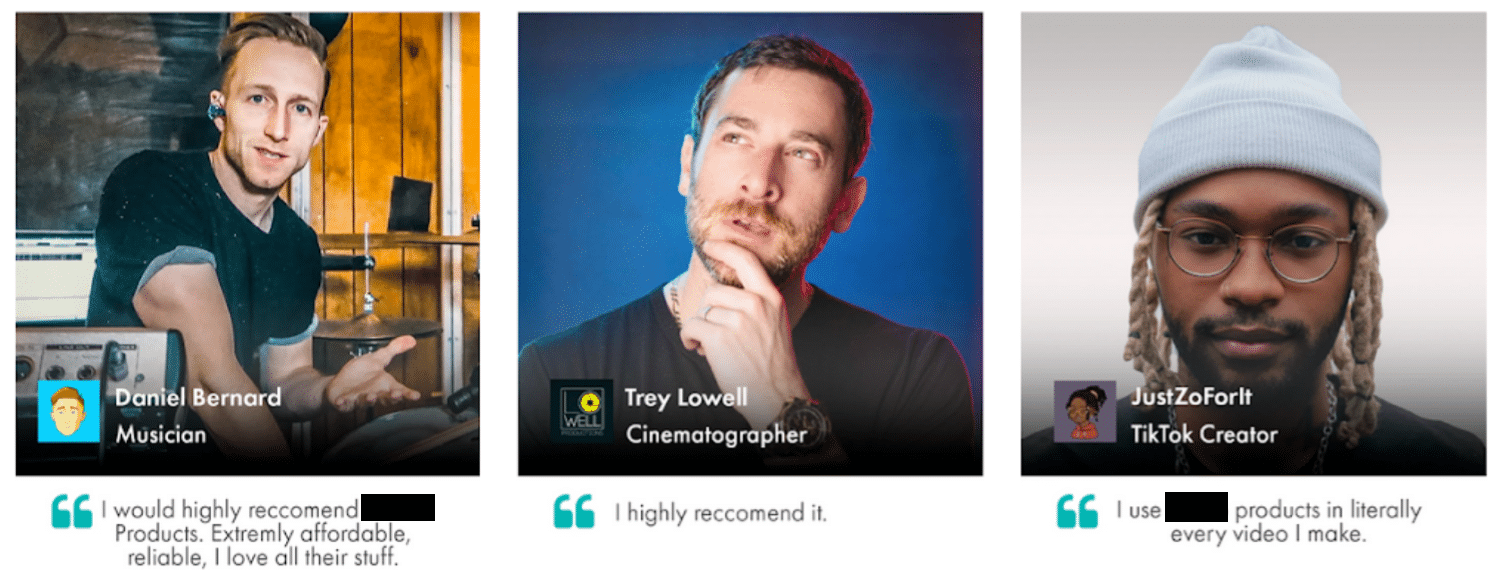
There are many other ways to add more content to your Shopify collections and increase your on-site engagement, but these are our top 3 recommendations for how to add to collection pages and make them more authoritative and engaging. If you want more information on how to increase your website’s authority, check out our guide on Authority-First SEO.
What are the Benefits of Optimizing Shopify Collections?
Without optimizing your Shopify collections, you’re missing out on traffic from non-branded, long-tail queries made by qualified customers in the browsing stage.
If you have other questions about Shopify SEO, you can contact Fire&Spark for a free consultation on how to take your ecommerce website to the next level.

